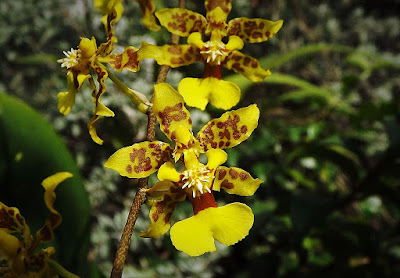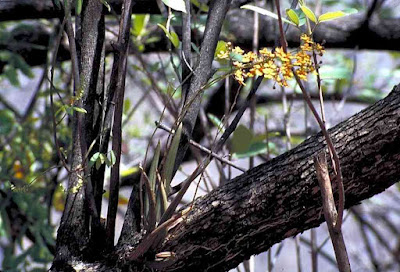Trichocentrum cebolleta are originally found in Colombia near Cartagena. It is widespread from Mexico through the Caribbean, Central America to Brazil, Paraguay and Argentina...
Trichocentrum cebolleta also called as The Onion Leaf Trichocentrum, Oncidium cebolleta, Cohniella cebolleta, Cymbidium juncifolium, Dendrobium cebolleta, Epidendrum cebolleta, Epidendrum juncifolium, Oncidium brachyphyllum, Oncidium cebolleta var. purum, Oncidium cepula, Oncidium glaziovii, Oncidium longifolium, Oncidium sepula, Oncidium sprucei, Oncidium ultrajectinum, Stilifolium cebolleta, Trichocentrum sprucei, is a species of the genus Trichocentrum. This species was described by Mark W. Chase & Norris Hagan Williams in 2001.
IDENTIFY TRICHOCENTRUM CEBOLLETA
Trichocentrum cebolleta are originally found in Colombia near Cartagena. It is widespread from Mexico through the Caribbean, Central America to Brazil, Paraguay and Argentina. They usually grow below 600 m in semi-arid regions or in areas with a clear dry season. However, there are reports of occurrence in more humid forest areas, even up to 1800 m. In Mexico, these plants are found as epiphytes in both semi-arid and humid forests, from sea level to 1800 m, although there are reports of encountering even at heights 2400 m. They appear in the states of Chiapas, Guerrero, Jalisco, México, Michoacán, Morelos, Nayarit, Oaxaca, Sinaloa, Sonor, Veracruz and Yucatán. But in Brazil they occur in all tropical regions, and occurrence has been confirmed in the Amazon Basin and in the north-eastern, south-eastern and central-western regions, including the states Acre, Amazon, Pará, Piaui, Pernambuco, Bahia Espírito Santo, Goiás, Tocantins, Mato Grosso, Minas Gerais, Roraima and Sao Paulo. In Peru they were encountered in the San Martín Department. They grew as epiphytes in a tropical, damp forest, in bright light, on old citrus trees near Moyobamba, about 5 km south of Tocache, at an altitude of 400 m.
It is a medium sized, hot to cool growing, caespitose, epiphytic species, which reaching up to 50 cm in height, with terete, sulcate, erect or suberect, fleshy, 7-50 cm long and 1.0-2.5 cm wide leaves and very small, tubular, 1.5-2.0 cm long pseudobulbs that are subtended by large white sheaths.
The Onion Leaf Trichocentrum blooms in the late winter and spring with a basal, arcuate, 75 cm long, simple or short branched, multi-flowered raceme arising on a newly matured pseudobulb. The small flowers of variable size grow on each inflorescence. The flowers may be 1.6-3.5 cm in diameter, but they are usually 2.5 cm wide measured by the wide spread petals of the inner whorl. The petals of both whorls are greenish-yellow with dark brown or red-brown spots. The yellow lip has reddish-brown spots on the middle and on the thickening and sometimes red dots on the underside. The spine is also yellow with dark purple-brown spots.
TRICHOCENTRUM CEBOLLETA CARE AND CULTURE
Cultural information should only be used as a guide, and should be to be adapted to suit you. Your physical location; where you grow your plants, how much time you have to devote to their care, and many other factors, will need to be taken into account. Only then can you decide on the cultural methods that best suit you and your plants.
Light:
Trichocentrum cebolleta needs a light level of 15000-30000 lux.
Temperature:
It is a thermophilic plant. The average temperature of the summer day is 30 ° C, and the summer night is 20-21 ° C, which gives a daily difference of 9-10 ° C. The average temperature of the winter day is 31-32 ° C, and the night 17-18 ° C, giving a daily difference of 13-14 ° C.
Humidity:
The Onion Leaf Trichocentrum needs the humidity of 75-80% in the growing season and 65-70% in the winter.
Substrate, growing media and repotting:
Trichocentrum cebolleta grow best and it is most convenient to grow them if they are attached to tree ferns or cork. Such cultivation requires, however, maintaining high humidity and in the summer of daily watering; in the case of heat, even several times. In the case of such suspended plants, during dry and hot periods it may be necessary to water several times a day. It is also possible to grow in pots filled with a loose, permeable base that allows the roots to dry quickly after watering.
Watering:
From late spring until autumn, the precipitation is moderate to heavy. The average monthly then drops slowly by going into a 3-month dry season lasting until spring. The cultivated plants should often be watered during the growing season, but their roots must dry very quickly.
Fertilizer:
During the active growth, the plants should be fertilized every week 1/4-1/2 of the recommended dose of fertilizer for orchids. A fertilizer with a high nitrogen content is beneficial from spring to mid-summer, and a fertilizer richer in phosphorus should be used in late summer and autumn.
Rest period:
In winter, the water should be reduced or completely eliminated, but the Trichocentrum cebolleta plants can not excessively dry up or remain dry for too long. Occasional fogging in the early morning between occasional watering, especially on sunny mornings, should protect the plant from too much drying out. Fertilization should be reduced or completely eliminated until new growths appear in the spring and normal watering is undertaken.















Thanks again
ReplyDelete